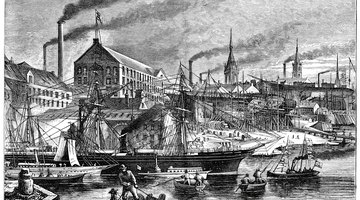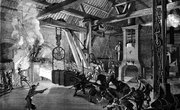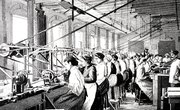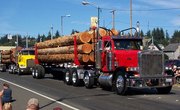The Industrial Revolution began in the late 18th century when a series of new inventions such as the spinning jenny and steam engine transformed manufacturing in Britain. The changes in British manufacturing spread across Europe and America, replacing traditional rural lifestyles as people migrated to cities in search of work. Men, women and children worked in the new factories operating machines that spun and wove cloth, or made pottery, paper and glass.
New Inventions Change Society
Until the Industrial Revolution, merchants who sold clothing usually had items manufactured one piece at a time by contractors working from home. Spinners made the yarn on a spinning wheel, and weavers wove it into cloth on a hand loom. Merchants would provide the necessary materials and then buy the finished products. During the Industrial Revolution these processes were automated and centralized. Instead of working from home, spinners and weavers worked together in large factories operating machines like the spinning jenny.
Jobs in the Textile Industry
The Industrial Revolution's impact was strongest and most immediate in the textile industry, as factories sprang up all over Britain to produce goods of cotton, wool, flax, silk and lace for sale in Britain and its overseas colonies. Factory workers operated spinning equipment such as the spinning jenny, water frame and spinning mule, or weaving equipment like the power loom. Factories could run up to 24 hours a day, six days a week, and a typical shift was 10 to 14 hours. Automated equipment with moving parts was inherently dangerous, but workers usually received no compensation if injured.
Other Jobs
Although most of the factories in the Industrial Revolution produced textiles, some produced other products like glass, paper or pottery, and iron works produced iron. Since steam engines demanded a constant supply of coal, there were many jobs in the coal mines. People also worked in jobs that were not industrialized, even at the height of the Industrial Revolution. For instance, despite the prevalence of female factory workers during this era, more women were employed as domestic servants and laundry women. A large sector of the population continued to be employed in agriculture.
The Workers
Women under 20 made up the majority of all factory workers, according to an article on the Industrial Revolution by the Economic History Association. Many power loom workers, and most water frame and spinning jenny workers, were women. However, few women were mule spinners, and male workers sometimes violently resisted attempts to hire women for this position, although some women did work as assistant mule spinners. Many children also worked in the factories and mines, operating the same dangerous equipment as adult workers.
Related Articles
References
Writer Bio
Scott Thompson has been writing professionally since 1990, beginning with the "Pequawket Valley News." He is the author of nine published books on topics such as history, martial arts, poetry and fantasy fiction. His work has also appeared in "Talebones" magazine and the "Strange Pleasures" anthology.











